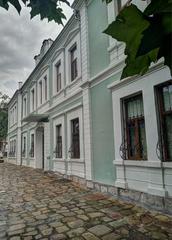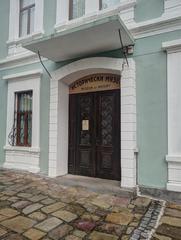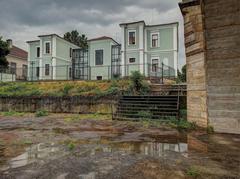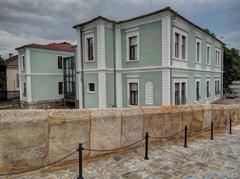
Humpback Bridge Visiting Hours, Tickets, and Historical Sites in Harmanli
Date: 01/08/2024
Introduction
The Humpback Bridge in Harmanli, Bulgaria, also known as the ‘Kemer Bridge,’ is a captivating historical site that stands as a testament to the architectural and engineering prowess of the Ottoman Empire. Constructed in the 16th century, this bridge has not only facilitated centuries of trade and travel but also served as a symbol of the cultural and economic connectivity within the Ottoman territories (tourtrans.eu). Known for its distinctive humpback design, the bridge spans approximately 29 meters in length and 3.5 meters in width, with a central arch rising about 8 meters above the riverbed. This architectural marvel has withstood the test of time, thanks in part to the meticulous dry stone masonry technique employed by its builders, which expertly integrated local stone to ensure both durability and flexibility (guidebg.com). Efforts to preserve this historical landmark have been robust, with significant restoration projects undertaken in the early 20th century and the 21st century. These projects have been supported by the Bulgarian government and international heritage organizations, recognizing the bridge’s importance as a cultural and historical treasure. Today, the Humpback Bridge is not only a historical monument but also a popular tourist attraction, drawing visitors from around the world who are eager to explore Bulgaria’s rich cultural heritage (tourtrans.eu). This guide aims to provide comprehensive information on the Humpback Bridge, including its history, visiting hours, ticket prices, travel tips, and nearby attractions, ensuring a fulfilling visit to this remarkable site.
Table of Contents
Historical Background
Origins and Construction
The Humpback Bridge in Harmanli, Bulgaria, also known as the “Kemer Bridge,” is a remarkable example of Ottoman-era architecture. Constructed in the 16th century, this bridge is a testament to the engineering prowess of the time. The exact date of construction is often debated, but it is widely believed to have been built during the reign of Sultan Suleiman the Magnificent, around 1585. The bridge was part of the strategic route connecting the Ottoman Empire’s capital, Istanbul, with the European territories.
Architectural Significance
The Humpback Bridge is an excellent example of Ottoman civil engineering and architectural design. The bridge spans approximately 29 meters in length and 3.5 meters in width, with a central arch that rises about 8 meters above the riverbed. The use of a single, large arch was a significant engineering achievement at the time, allowing for a wide span without the need for multiple supports in the river, which could obstruct water flow and accumulate debris. The bridge’s construction techniques reflect the advanced knowledge of materials and structural dynamics possessed by Ottoman engineers. The stones used in the bridge were meticulously cut and fitted together without the use of mortar, a technique known as dry stone masonry. This method not only provided flexibility to the structure, allowing it to withstand seismic activity, but also contributed to its longevity.
Historical Role and Importance
Throughout its history, the Humpback Bridge has played a crucial role in the region’s transportation and trade networks. During the Ottoman period, it facilitated the movement of goods, people, and military forces between the empire’s European and Asian territories. The bridge was part of the “Via Militaris,” a major military and trade route that connected Belgrade to Istanbul. This route was vital for the economic and strategic interests of the Ottoman Empire, and the Humpback Bridge was a key infrastructure element supporting this network. In addition to its practical functions, the bridge also held symbolic significance. It represented the Ottoman Empire’s ability to integrate and connect diverse regions under its control, fostering economic and cultural exchanges. The bridge’s enduring presence is a testament to the empire’s architectural and engineering achievements.
Preservation and Restoration Efforts
Over the centuries, the Humpback Bridge has undergone several restoration efforts to preserve its structural integrity and historical value. The first significant restoration took place in the early 20th century, when the bridge was reinforced to address wear and tear from centuries of use. More recently, in the 21st century, the Bulgarian government, in collaboration with local and international heritage organizations, has undertaken comprehensive restoration projects to ensure the bridge’s preservation for future generations. These restoration efforts have focused on maintaining the bridge’s original architectural features while incorporating modern conservation techniques. For instance, damaged stones have been carefully replaced with matching materials, and structural reinforcements have been added to enhance stability without altering the bridge’s historical appearance. These initiatives have been supported by funding from the European Union and other international bodies, recognizing the bridge’s cultural and historical significance.
Cultural and Tourist Significance
Today, the Humpback Bridge is not only a historical monument but also a popular tourist attraction. It draws visitors from around the world who are interested in exploring Bulgaria’s rich cultural heritage. The bridge is part of the “Cultural Route of the Ottoman Heritage,” a tourism initiative that highlights significant Ottoman-era sites across the Balkans. Visitors to the Humpback Bridge can enjoy its picturesque setting over the Harmanli River, surrounded by lush greenery and scenic landscapes. The bridge is accessible year-round, and local authorities have developed amenities such as walking paths, informational plaques, and guided tours to enhance the visitor experience. These efforts aim to educate the public about the bridge’s historical context and architectural features, fostering a deeper appreciation for this remarkable structure.
Local Legends and Folklore
The Humpback Bridge is also steeped in local legends and folklore, adding to its cultural allure. One popular legend tells the story of a master builder who, upon completing the bridge, was so proud of his work that he declared it would stand for a thousand years. According to the tale, the builder’s boast angered the gods, who cursed the bridge to be destroyed by a great flood. However, the bridge withstood the flood, and the builder’s prophecy was fulfilled, cementing the bridge’s legendary status in local lore. Another story involves a hidden treasure said to be buried beneath the bridge, attracting treasure hunters and adventurers over the years. While no treasure has ever been found, these legends contribute to the bridge’s mystique and draw visitors intrigued by its storied past.
Visiting Information
Visiting Hours
The Humpback Bridge is open to visitors year-round. Typical visiting hours are from 8:00 AM to 6:00 PM daily. However, it is advisable to check the official tourism website of Harmanli for any changes in visiting hours due to special events or maintenance activities.
Ticket Prices
There is no admission fee to visit the Humpback Bridge. Visitors can freely explore the site and enjoy the surrounding natural beauty at no cost.
Getting There
The Humpback Bridge is located in Harmanli, Bulgaria, and is easily accessible by road. Visitors can reach Harmanli by bus or car from major cities like Sofia and Plovdiv. The bridge is well-signposted, and there is ample parking available nearby.
Best Times to Visit
The best times to visit the Humpback Bridge are during the spring and autumn months when the weather is mild and the surrounding landscapes are particularly scenic. Early morning and late afternoon visits are recommended for those who wish to avoid the midday crowds and capture the best photographic light.
Accessibility
The bridge and its immediate surroundings are accessible to visitors with limited mobility. However, some areas may have uneven terrain, so it is advisable to take necessary precautions.
Nearby Attractions
While visiting the Humpback Bridge, tourists can also explore other historical sites in Harmanli, such as the Harmanli Historical Museum and the Church of St. Athanasius. These attractions provide further insight into the region’s rich cultural and historical heritage.
FAQ
What are the visiting hours for the Humpback Bridge?
The Humpback Bridge is open daily from 8:00 AM to 6:00 PM.
Is there an admission fee to visit the Humpback Bridge?
No, there is no admission fee to visit the Humpback Bridge.
How can I get to the Humpback Bridge?
The bridge is located in Harmanli, Bulgaria, and can be reached by bus or car from major cities like Sofia and Plovdiv.
Is the Humpback Bridge accessible to disabled visitors?
Yes, the bridge and its surroundings are accessible to visitors with limited mobility, although some areas may have uneven terrain.
Conclusion
The Humpback Bridge in Harmanli, Bulgaria, is a remarkable historical and architectural landmark that offers a window into the region’s Ottoman heritage. Its enduring presence and the efforts to preserve it highlight the bridge’s significance as a cultural and historical treasure. Visitors to the bridge can not only appreciate its architectural beauty but also immerse themselves in the rich history and legends that surround this iconic structure. For more information, you can visit the official tourism website of Harmanli.





